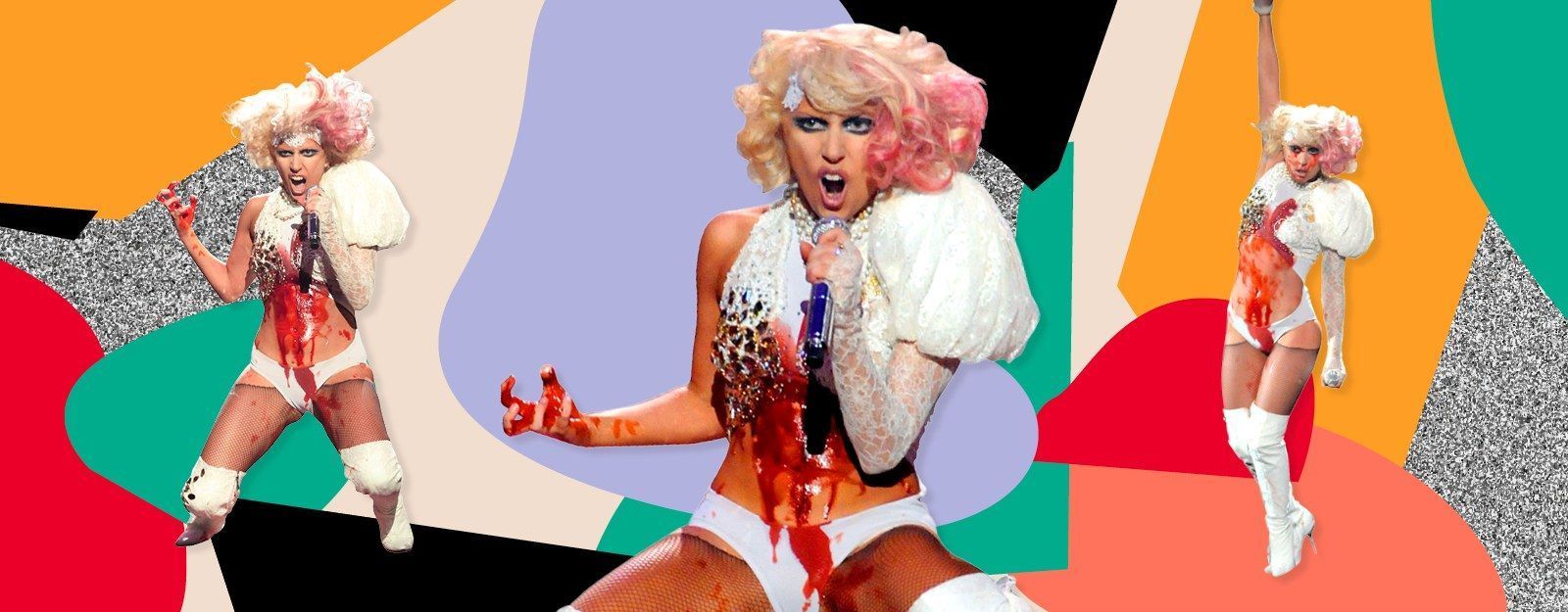Lady Gaga’s 2009 MTV Video Music Awards Performance Was a Warning Pop Culture Needed

“Amidst all of these flashing lights, I pray the fame won’t take my life,” Lady Gaga says operatically at the top of her performance at the 2009 MTV Video Music Awards. Her statement is a double entendre of sorts: It’s a nod to her debut album, The Fame—which turns 10 years old this Sunday (August 19)—but also something poignant at face value. Gaga was only a year into pop superstardom at the time, so “the fame” hadn’t taken her life yet. But she had plenty of evidence to think it could.
After all, look at pop culture in 2009 and the late 2000s in general. Tabloids, photographers, and the 24-hour news-cycle thrived on the rise and fall of female celebrities like Britney Spears, Lindsay Lohan, and Paris Hilton. These women, at one point, were as celebrated and beloved as Gaga was in 2009, but the tide always turned. Tabloids sensationalized every mistake and mishap. Every stumble out of a nightclub or wardrobe malfunction became front-page news. They went from pop stars to punchlines.
Spears’ fall from grace was perhaps the most documented—and severe. She reached a critical point in January 2008 when, after barricading herself in a bathroom, she was strapped to a gurney and placed on an involuntary 72-hour hold at Cedars-Sinai Medical Center. Photographers documented the entire ordeal, at one point getting so close to the ambulance escorting Spears they could touch it.

Britney Spears in January 2008.
This wasn’t just a night out gone wrong: Spears was in serious medical trouble, and the world wanted a front seat to the action. That’s when things became frighteningly clear: We weren’t just mocking women like Britney Spears and Lindsay Lohan. We were destroying them.
Lady Gaga knew this. “I was just reading tabloids like they were textbooks,” she told CNN in 2009 about how she created her first album. “I would buy every scandal book, every paper, every magazine that I could get my hands on, and I would tear sheets out.” That investigation led to The Fame, a record that’s largely an electro-pop fantasy but is also a warning to leave female tabloid fixtures alone.
You hear and see that warning the most on “Paparazzi,” the fifth single from The Fame, which Gaga performed at the 2009 MTV VMAs. At first glance “Paparazzi” is a sunny, disco-fied ode to infatuation—”I’m your biggest fan, I’ll follow you until you love me,” she sings during the chorus—but her live performances give the song new meaning. The way she says “paparazzi” during her VMAs set, for example, is so harsh it suggests infatuation isn’t always innocent. It can border on scary, just as it did with Spears in 2008.
And then, of course, there’s what happens at the end of the performance: Gaga bleeds to death and is strung up by her dancers, her eyes glassy and lifeless. In the background you hear the faint sound of paparazzi snaps; flashes shine on her “dead” body as if people are taking pictures. We’ve essentially just witnessed the demise of Lady Gaga and instead of seeking help, we’re spectating.
It’s a pretty on-the-nose metaphor for what was happening in Hollywood at that period. No, Britney Spears and Lindsay Lohan weren’t killed in the literal sense, but the scrutiny Gaga illuminated here is what they experienced. The image of a swarm of male photographers chasing after Lohan in some kind of modern witch hunt is just as disturbing and graphic as Gaga’s rehearsed downfall at the VMAs. In 2009 few batted an eye at the frenzied and rabid way photographers treated celebrity women. “Well, they asked for it” was a common way to dismiss it. But you couldn’t dismiss the image of Gaga bleeding on stage: It shed a light on how terrifying that behavior actually is—and where it can lead.
She did the same thing with the music video for “Paparazzi.” It kicks off with her fictional boyfriend, played by actor Alexander Skarsgård, throwing her off a balcony right in front of photographers, who gleefully document the incident. As a result, Gaga becomes paralyzed from the waist down, leading newspapers to declare she’s “hit rock bottom” and her career is “over.” She redeems herself in the end by killing her boyfriend: a drastic act that prompts those same papers to declare, “We love her again!”
This is more or less an exaggerated version of what happened to Spears. A cleaned-up appearance at the 2008 VMAs and new album, Circus, rehabilitated her image, and the same gossip sites that were hungry for her failure seven months prior were now her biggest champions. It was a sharp turn that felt to me as if people didn’t really care about Spears: They just wanted to watch her life play out like a movie. In many ways the public could be perceived as having destroyed her just to raise her up again—something they’ve done in various ways to artists like Courtney Love, Madonna, and the late Whitney Houston and Amy Winehouse. Back then the world delighted in seeing famous women have it all, lose it all, and claw their way back to the top. Gaga clocked this phenomenon in her own subversive way—and showed just how sinister it truly is.
Thankfully, our culture’s come along way since 2008. Look at the reaction to Demi Lovato’s recent relapse and hospitalization. Instead of mocking her addiction, the response has been overwhelmingly supportive. We’ve moved into a kinder, more empathetic space.
To me, Lady Gaga absolutely had something to do with this shift. With The Fame and, more specifically, “Paparazzi,” Gaga stood with these women before anyone else did—before society caught up. It was armor for scrutinized women: a song that simultaneously showed what was happening to them and what could happen if the media’s attitude didn’t change. Gaga literally crucified herself on stage to tell the world this—and stop it.
Christopher Rosa is the entertainment staff writer at Glamour.

